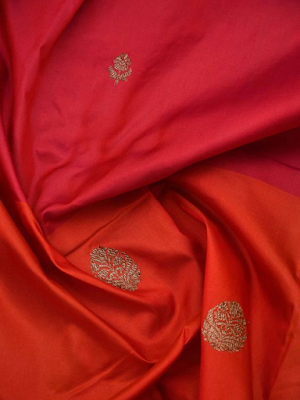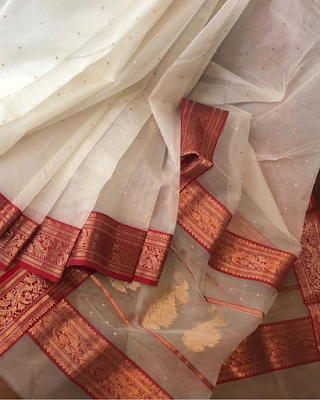Timeless Drapes
A Walkthrough the Lane of Indian Fabrics
India, where traditions weaves together to bring out artistry from attires. Each fabric whispers its tale of craft, and such a masterpiece lies in every household of this country. One of its elegant illustrations would be "Sarees." With its each drape and intricate folds, it unfolds the realm of traditions and culture. In this blog, we will unravel the world of sarees. From Kanchipuram to Banarsi, one pleat at a time.
Bandhani:
 |
| Bandhani Saree |
Bandhani saree is majorly found in Gujarat and Rajasthan. These sarees are crafted from the finest threads of cotton or silk. It's the art of tie-dye. Bandhani is the centerpiece in the world of tie and dye. Highly skilled artisans paint the fabrics with their hands, bringing out the best color blends. With every thread dyed, a story is woven, creating intricate designs like Chandrakala, Bavan Baug, and Shikari, a symphony of colors and creativity.
Kanchipuram Silk:
 |
| Kanchipuram Silk Saree |
The "Queen of Silks" - Kanchipuram Sarees are a cultural treasure of the city of Kanchipuram, Tamil Nadu. Made from mulberry silk, what sets Kanchipuram sarees apart is their silk fabric, distinguished by its sheer quality, lustrous texture, and enduring elegance. The hallmark of a Kanchipuram saree is its rich and intricate zari work, which adorns the borders of the fabric. Creating these masterpieces takes weeks and months. In Kanchipuram, the body and border of the saree are designed separately and later interlocked. These sarees are known for their durability and timeless beauty, making them a symbol of grace and heritage.
Banarsi Silk:
 |
| Banarsi Silk Saree |
Found in the ancient city of Varanasi, Banarsi sarees are a mark of centuries-old tradition and culture. Famous for its brocade and zari, Banarsi is one of the finest sarees to ever exist. These sarees come in a plethora of styles, from the classic and regal Katan silk to the delicate and ethereal Organza to the sheer and fashionable Georgette, offering a rich variety that suits every occasion, from weddings to cultural celebrations.
Kota Doria:
 |
| Kota Doria Saree |
As the name suggests, Kota Doria is woven in the pit looms of the historic town Kota in Rajasthan. It is the perfect and unique blend of cotton and silk threads. Their identity and artistry lie in the square-shaped checks, famously known as "khat." These checks, designed with delicate motifs, lend elegance to the sarees, making them perfect for both everyday wear and special occasions. They are also minutely woven, making them lightweight and a choice for every choice.
Baluchari:
 |
| Baluchari Saree |
Hailed from the serene town of Baluchar in West Bengal, Baluchar sarees are a testament to the old art of intricate patterns. The prominent material used is silk, and polishing is done once the weaving process is complete. They have detailed and elaborate depictions of mythological and cultural narratives, especially adorning the "pallu" region of the attire. Crafted primarily from fine silk, they are known for their lightweight drape and rich, vibrant colors. Baluchari sarees are a timeless bridge between history and contemporary fashion, making them a treasured choice.
Chanderi:
 |
| Chanderi Saree |
Tracing the origin of Chanderi brings us back to the 2nd and 7th centuries. The weaving culture of Chanderi emerged in the historic town of Chanderi in Madhya Pradesh. These Sarees are crafted with a blend of pure silk, Chanderi cotton, and silk cotton. What truly sets Chanderi sarees apart are the delicate and intricate motifs, often inspired by nature, which are skillfully handwoven with precision. The hallmark of such sarees is their gossamer-like texture, which drapes gracefully and shimmers with a subtle translucence.
Sarees have been a symbol of grace and empowerment for generations, and they continue to evolve while retaining their timeless allure. And thus celebrating this tradition, we've taken an exhilarating journey from the traditional Banarasi to the charm of Chanderi, and from the vibrant Bandhani to the artistry of Baluchari.

Comments
Post a Comment